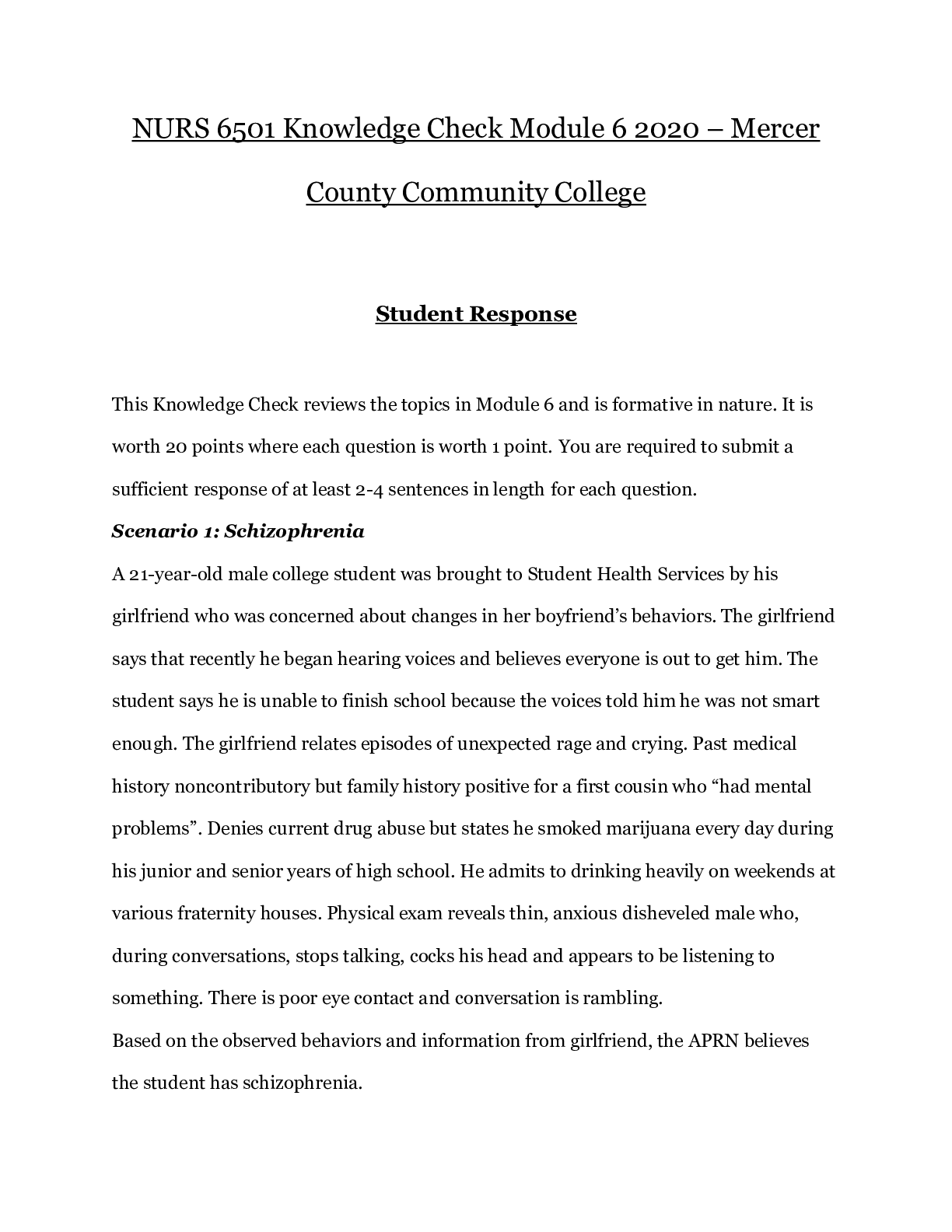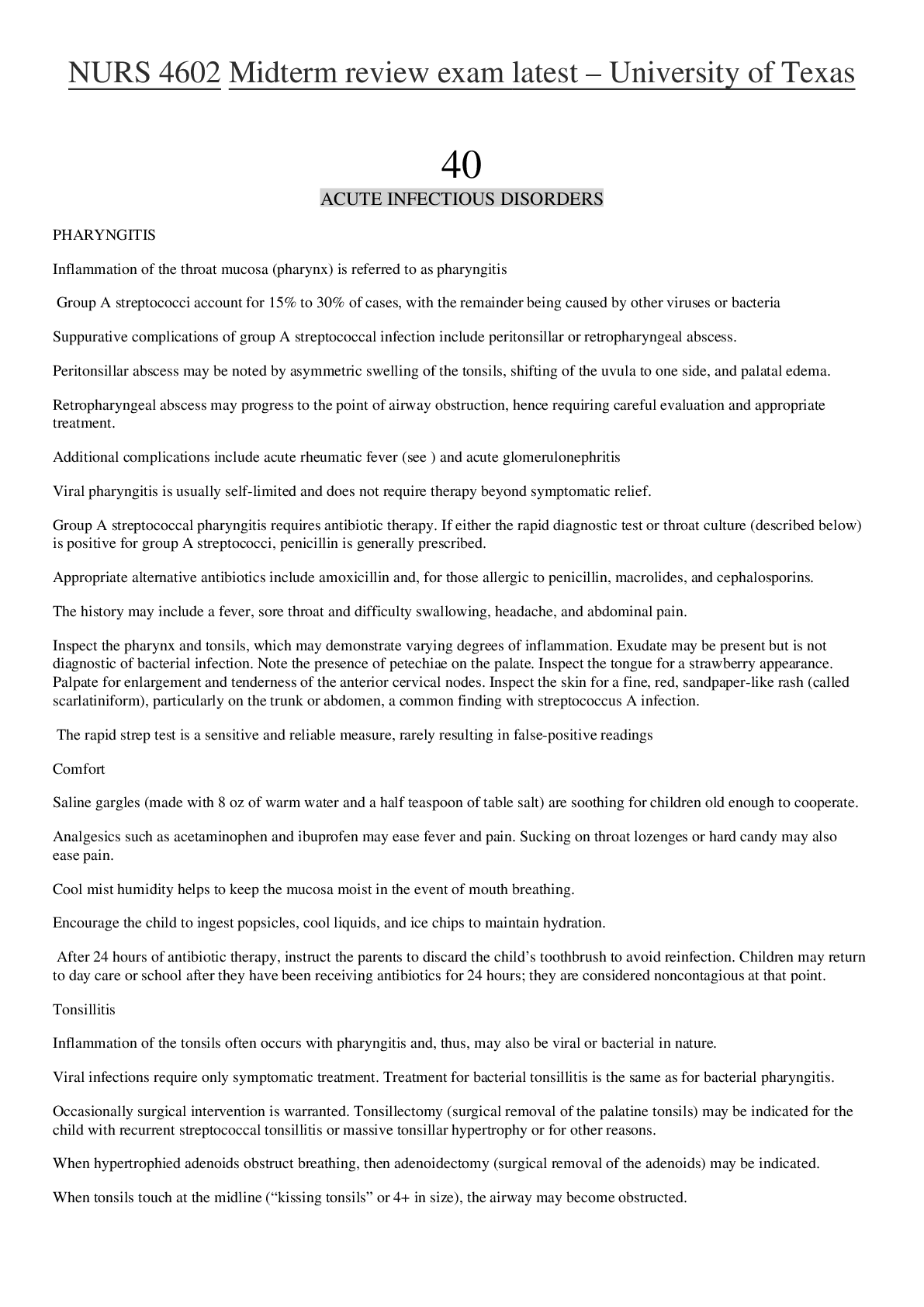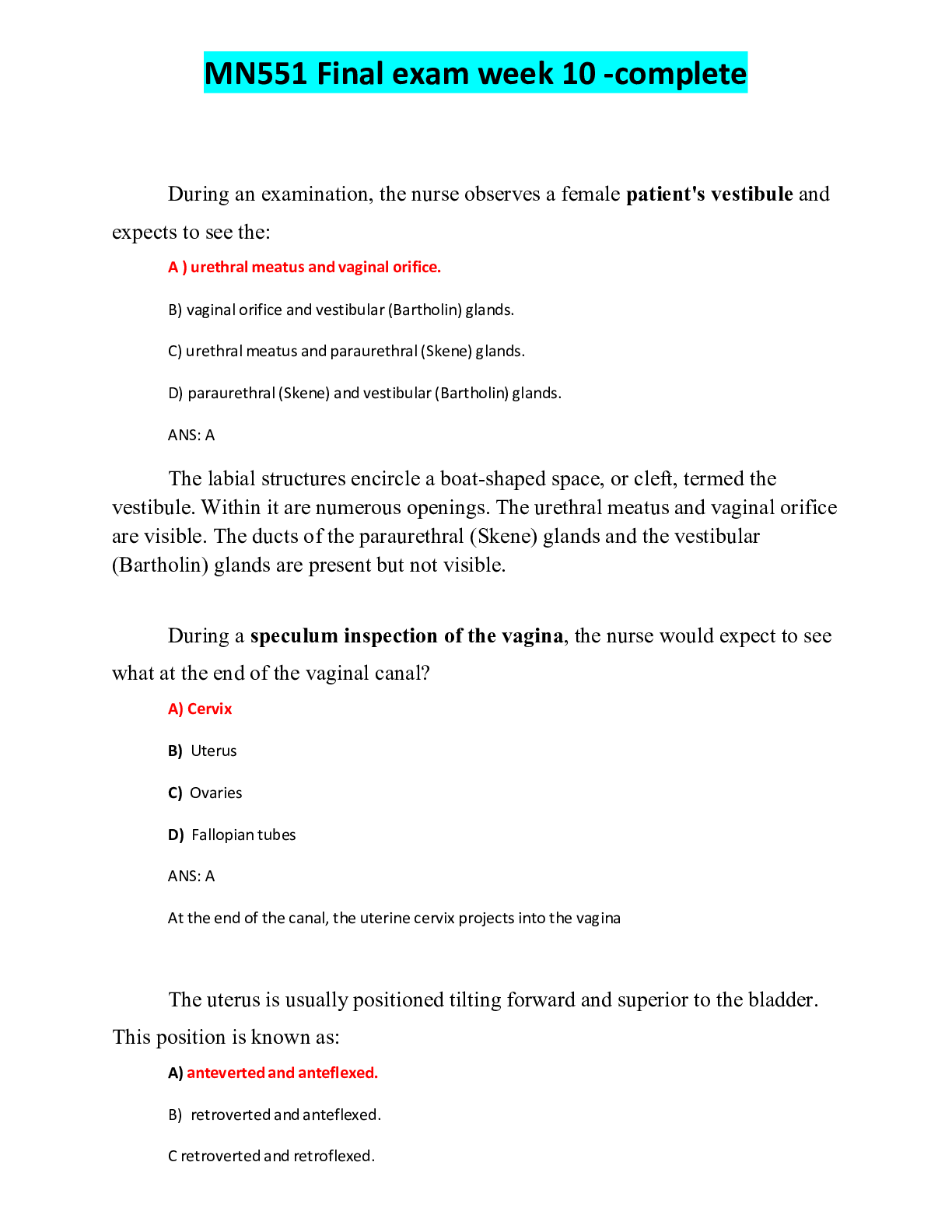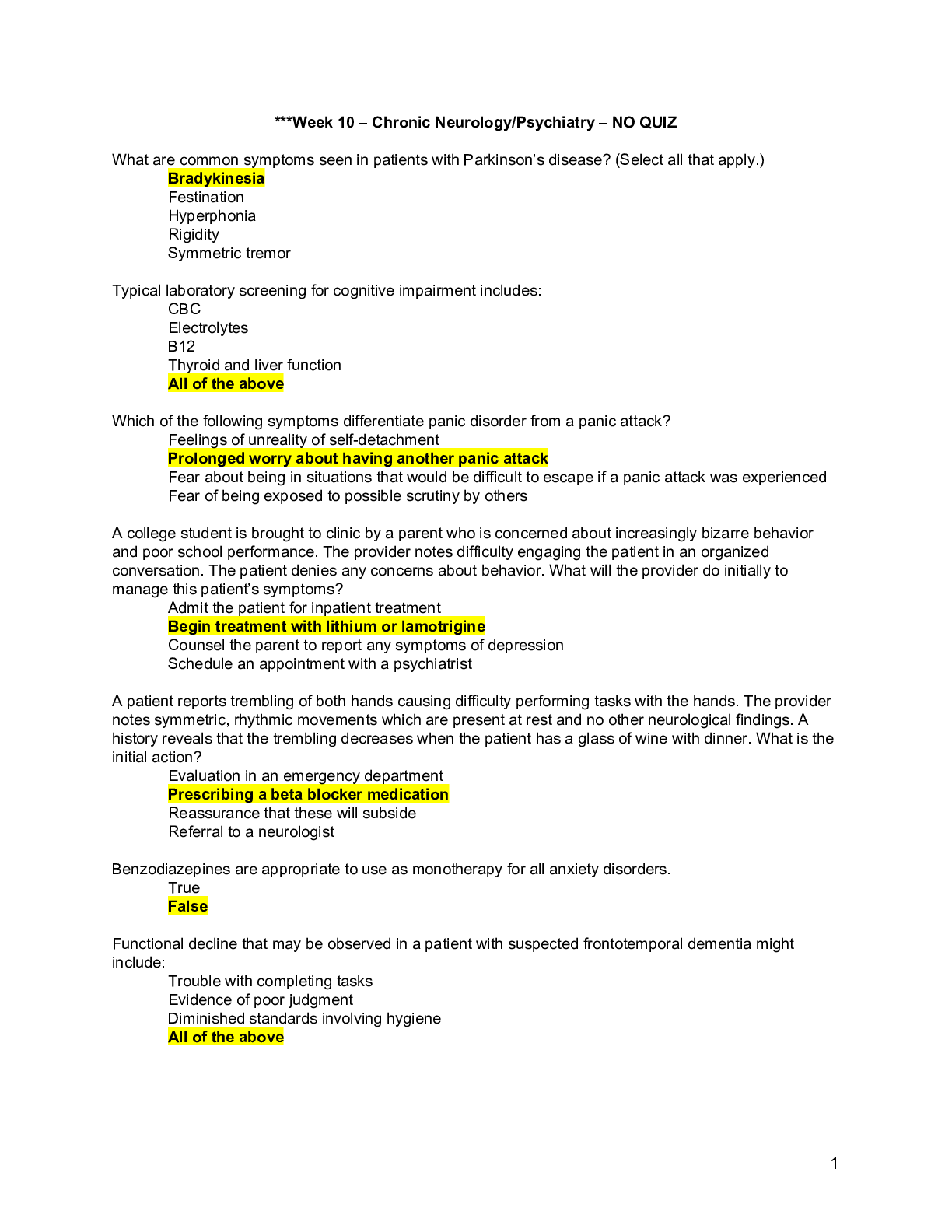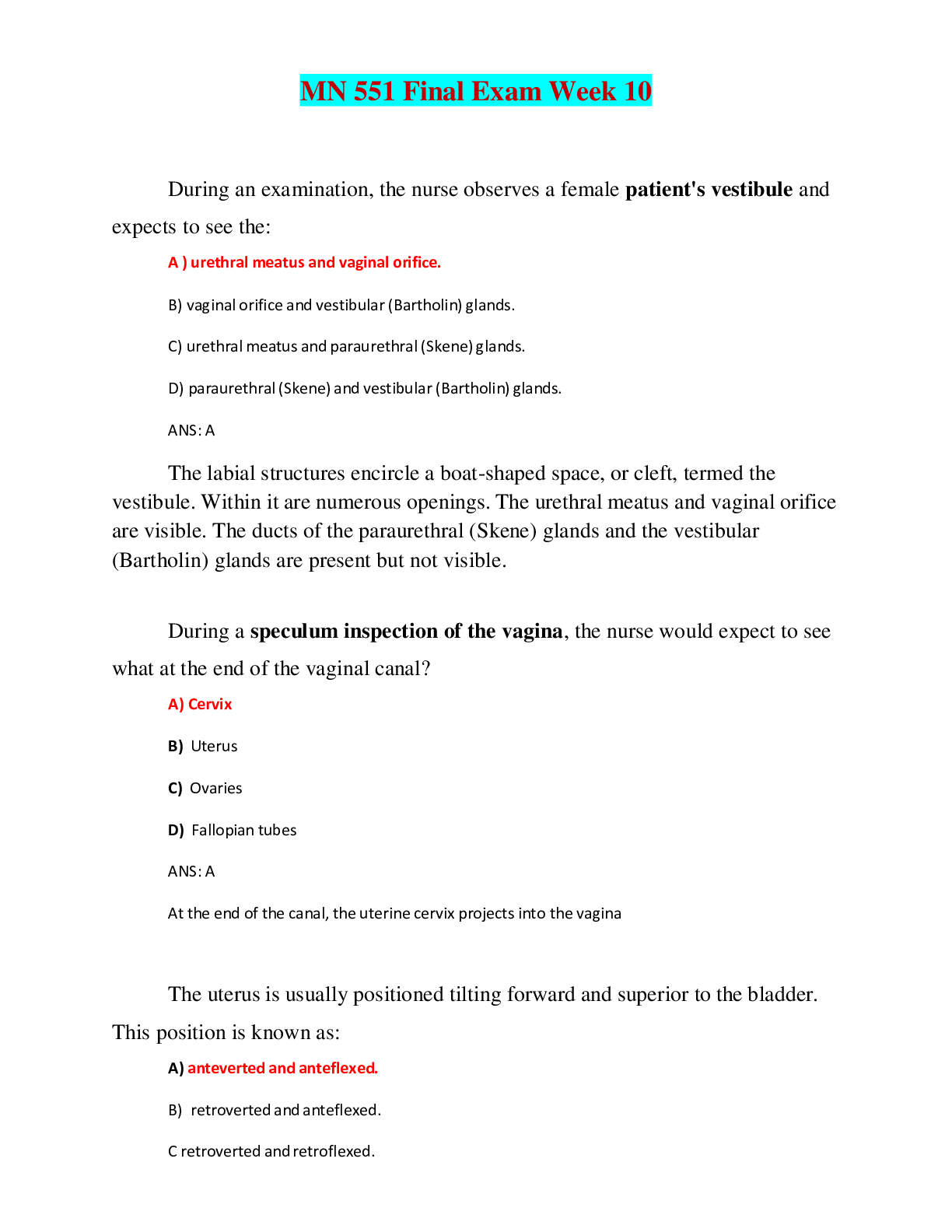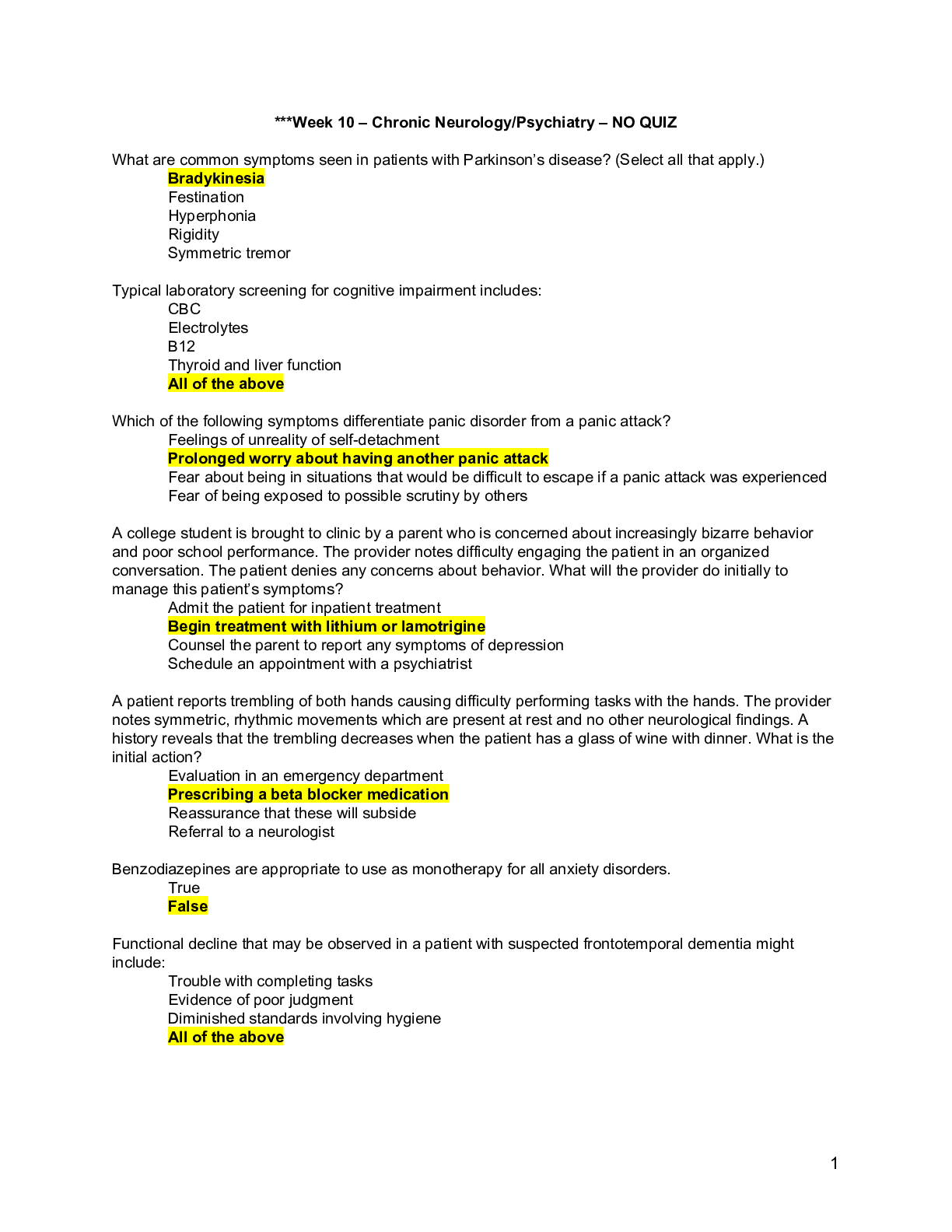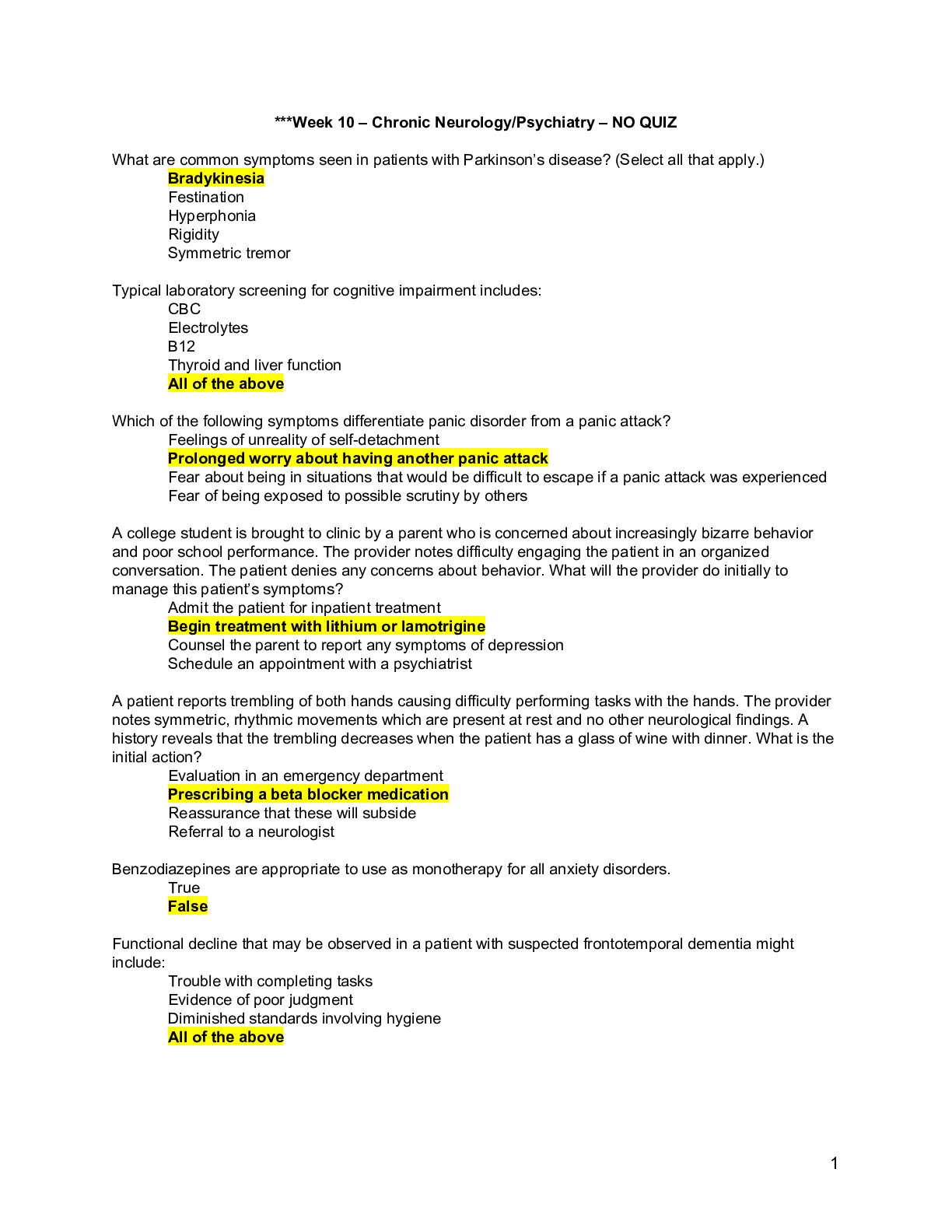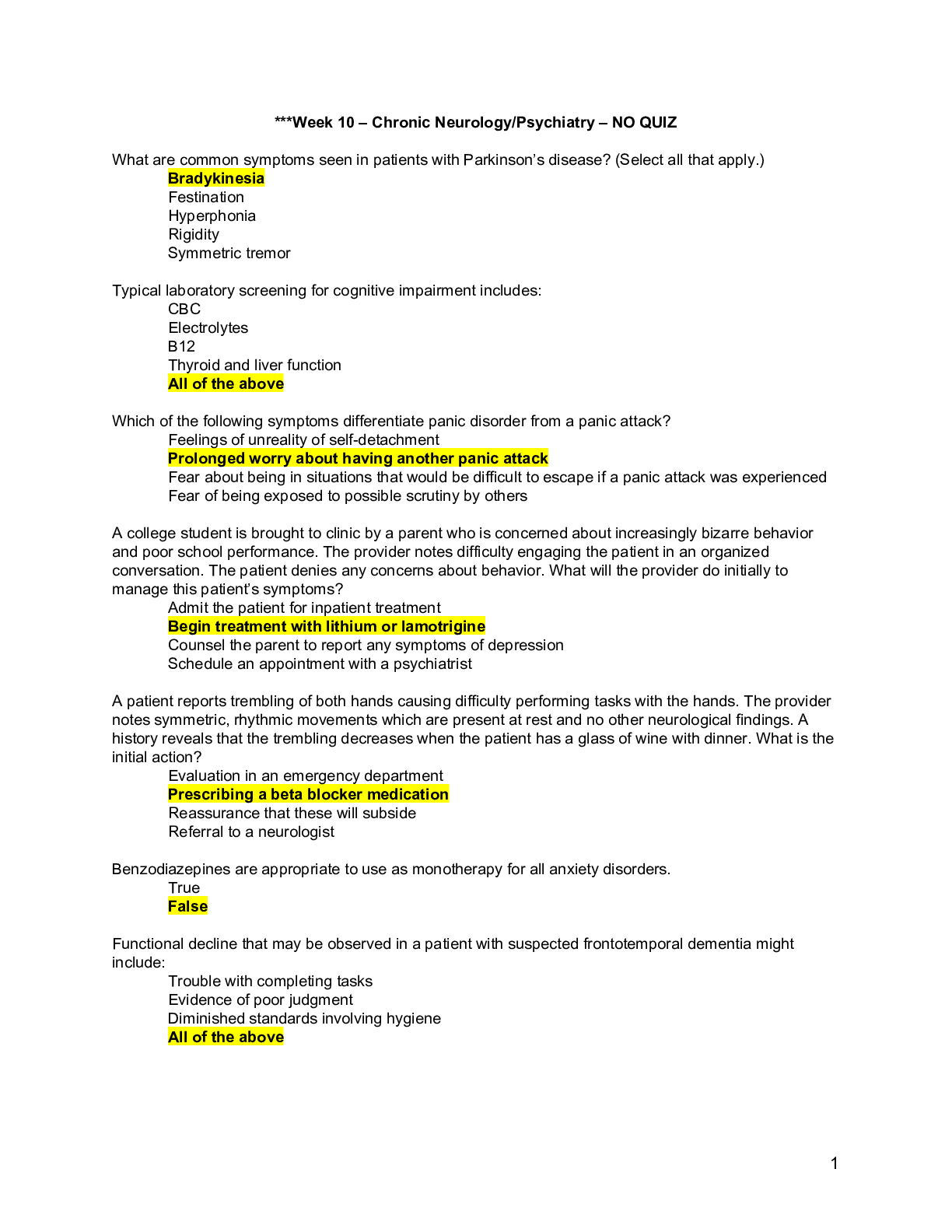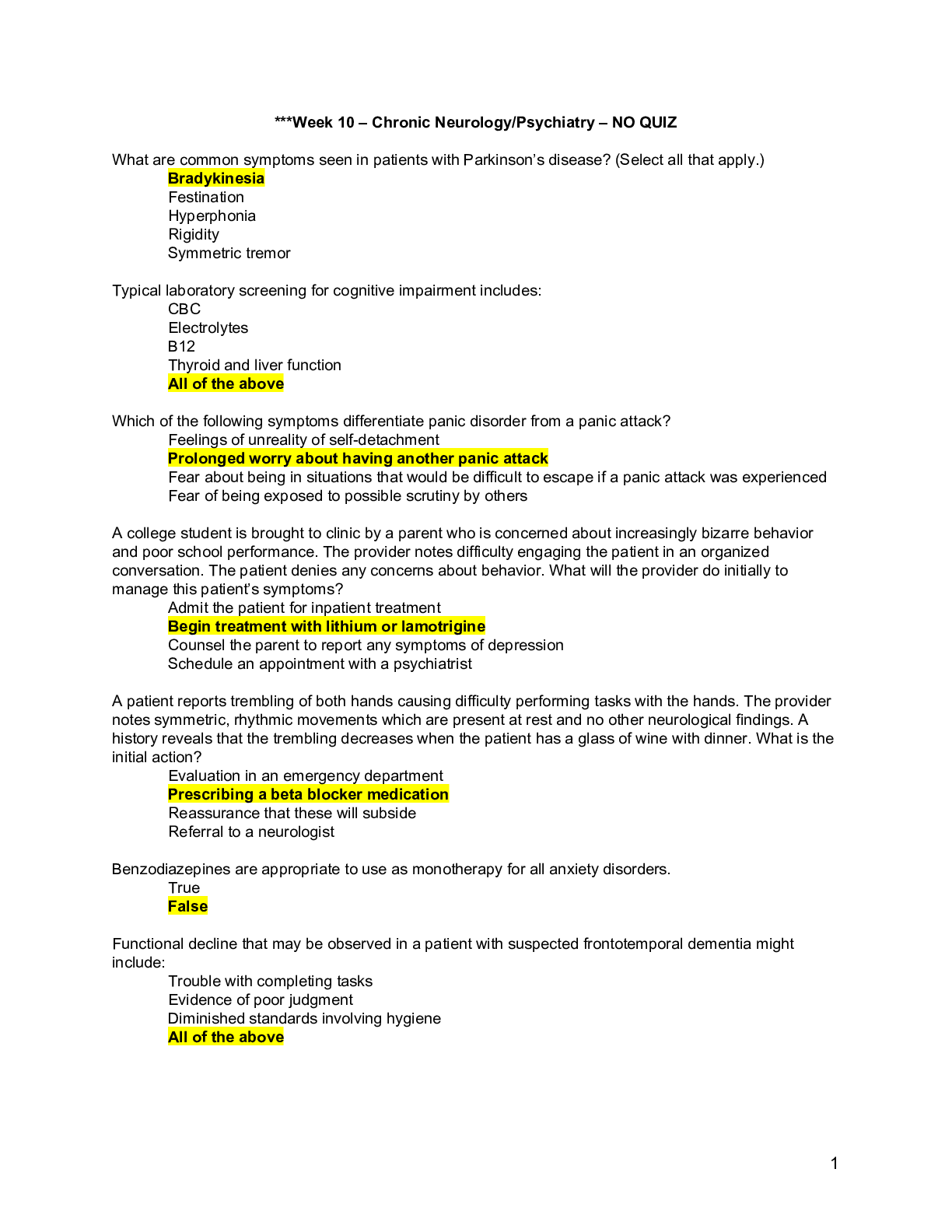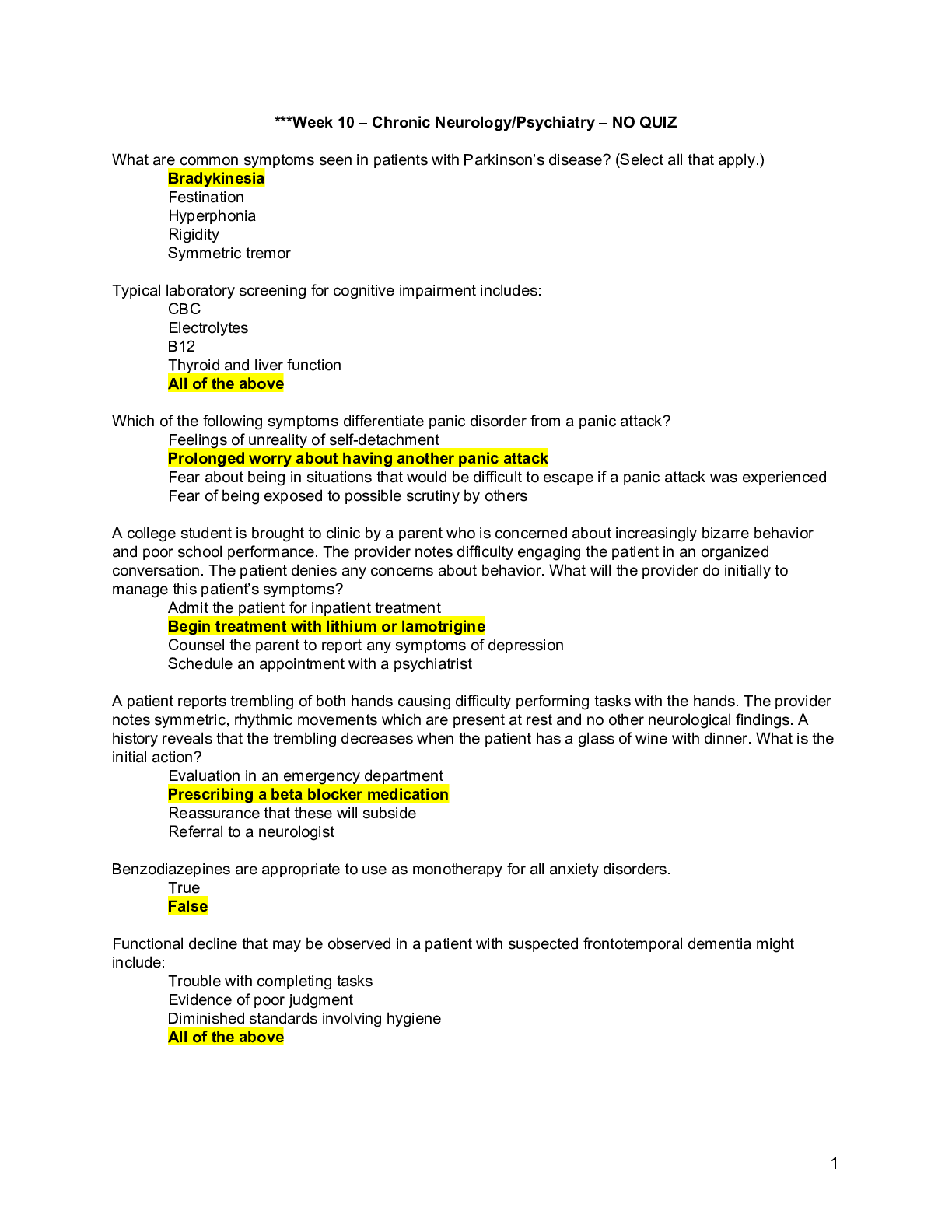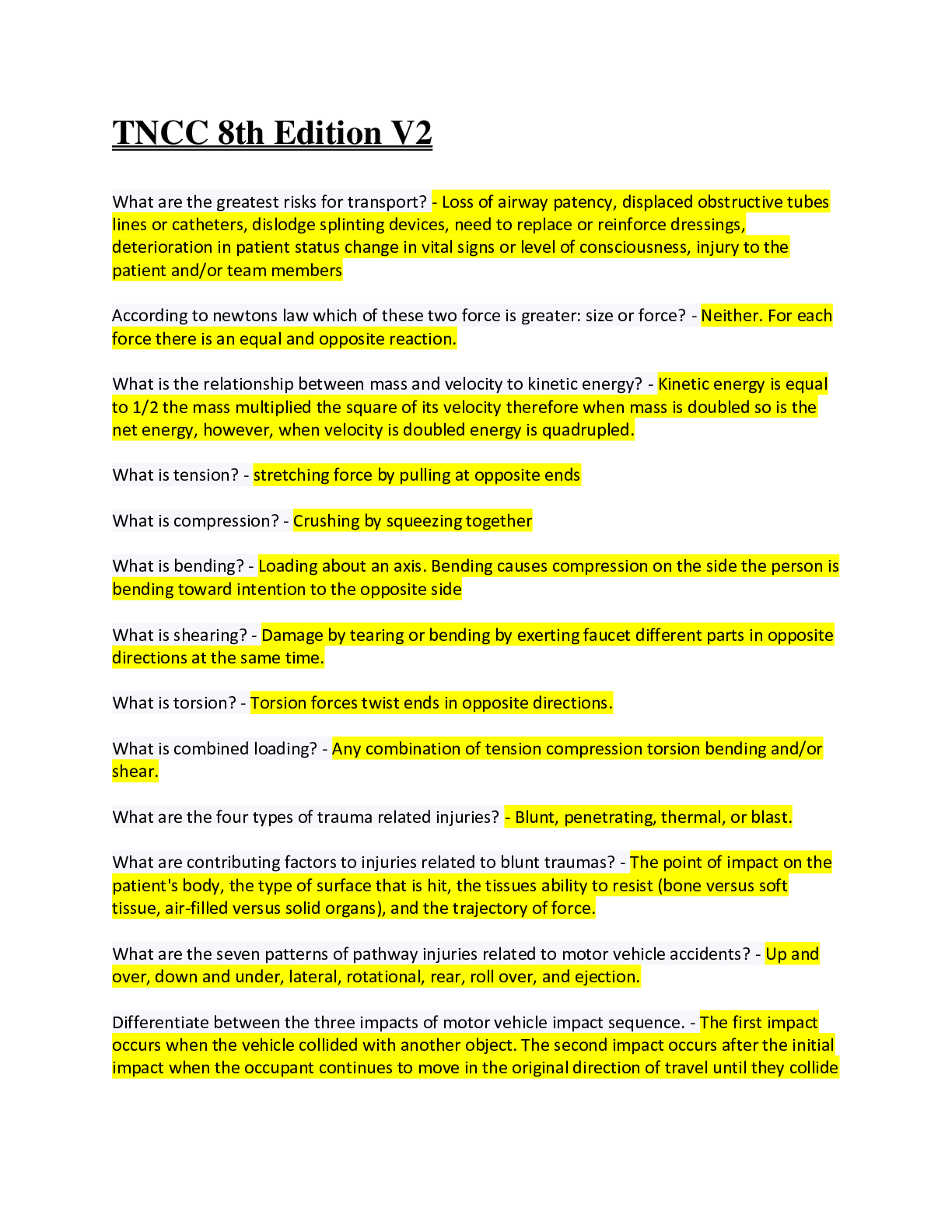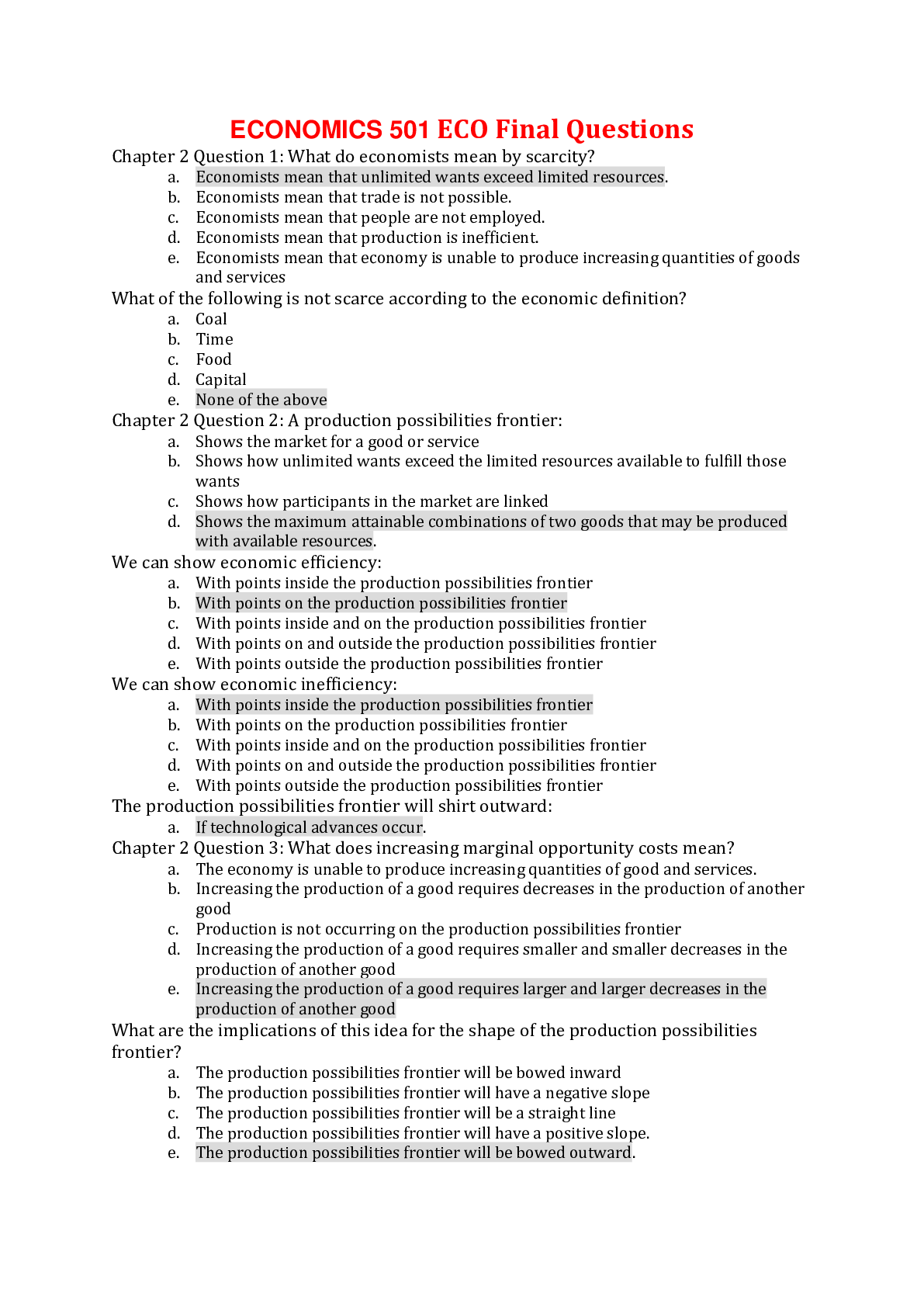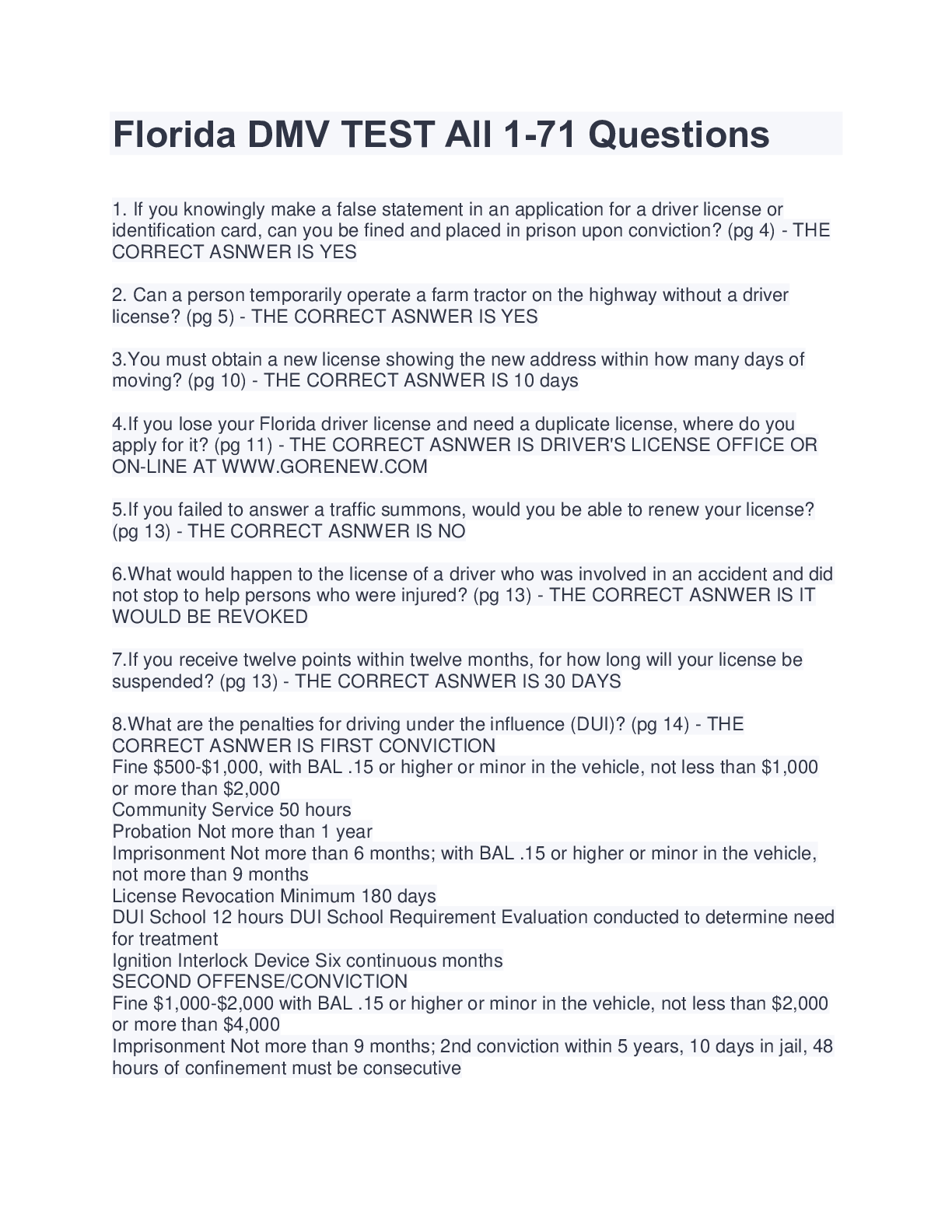NURS 4601 Week 10 - Neuro Critical Thinking latest – University of Texas
Document Content and Description Below
NURS 4601 Week 10 - Neuro Critical Thinking latest – University of Texas Can Noncompliance to Antihypertensive Medications Cause Stroke? NURS 4601-M University of Texas Rio-Grande Valley ... Problem/Issue A 57-year-old Hispanic female patient, Mrs. B, came in to the Emergency Room with new onset Atrial Fibrillation with Rapid Ventricular Response (RVR). She was admitted to telemetry unit after being converted to normal sinus rhythm with a calcium channel blocker (diltiazem). An hour later the client’s daughter voiced her concern and says, “mom’s acting kind of funny”. Upon primary nurse’s assessment, the client had a left sided facial droop, slurred speech, and was unable to hold her left arm up for more than 3 seconds. The patient lives alone with her two cats in Mission since the death of her husband two years ago. She refuses to relocate to an assisted living facility as she claims that it is a waste of money as her daughter lives right down the street from her. The client had history of hypertension, dyslipidemia, hyperthyroidism, and a curative remote mastectomy for breast cancer. Her daughter states that client has no longer been attending the senior exercise class at church and has been non-compliant with her antihypertensive medications at home. The goal is to identify if the noncompliance of antihypertensive medications could’ve caused the patient’s stroke? Identified Facts The patient came to the hospital because of new onset Atrial Fibrillation with Rapid Ventricular Response (RVR). Upon primary nurse’s assessment, the client had a left sided facial droop, slurred speech, and was unable to hold her left arm up for more than 3 seconds. The nurse immediately called a Code Stroke and the charge nurse for help. The neurologist arrived at bedside within 7-9 minutes to assess the client and her NIH Stroke Scale score was a 32. He ordered a STAT CT scan, which showed that there was no bleeding in the brain. The client was qualified for a thrombolytic such as tPA (alteplase). After 2 hours, the client was showing signs of improvement. She was able to speak more clearly, though with a slight slur. She was still slightly weak on the left side but was able to hold her arm up for 10 seconds by now. Her NIHSS was now 6 at this time. Assumptions My assumption is that hypertension is a risk factor for stroke, which is the reason why it is so important for high blood pressure patients to have antihypertensive medication. Compliance with the therapeutic regimen is the main goal of health care professionals in hypertensive treatment. The treatment of hypertension is started nowadays with non-pharmacological therapy through a modification of lifestyle such as weight reduction, increase physical activity, moderation of dietary sodium and fat, limited alcohol intake and avoidance of stress. It is estimated that 51% of the hypertensive patients stop their anti-hypertensive medication within one year of its initiation. Non-compliance with the therapeutic regimen such as (anti-hypertensive medication, dietary restrictions of sodium and fat, weight reduction, exercise program, and smoking) is usually the main cause of hypertensive complications and mainly stroke. (apa -66) Inferences High blood pressure puts a strain on all the blood vessels throughout your body, including the ones leading to the brain. As a result, your heart has to work much harder to keep the blood circulation going. This strain can damage your blood vessels, causing them to become harder and narrower, a condition called atherosclerosis. This makes a blockage more likely to occur, which could cause a stroke or TIA (transient ischemic attack, sometimes called a mini stroke). (APA -uk) Applicable Nursing Concepts Begin education early in the client’s hospital stay and reinforce teachings on a regular basis. Healthcare professionals should provide written materials, as stroke survivors and their families report difficulty recalling information given during the hospital stay. Post-discharge follow-up programs (by telephone or in person) to identify concerns about medications and to ensure all prescriptions have been filled can boost adherence. Not only must the healthcare team provide information about secondary-prevention drugs clients will take after discharge (including antiplatelets or anticoagulants, antihypertensives, and statins); but we also must assess for potential barriers to adherence. Post stroke disabilities, such as swallowing difficulties, motor weakness, and cognitive impairment, may interfere with medication management. Involving family members (especially the primary family caregiver) in discussions about medications is very important. Also, another aspect to assess is the client’s financial and insurance-related issues. If inadequate finances are a potential barrier to medication adherence, a consult with a social worker should be made. Applicable Research Findings According to the article, the goal is to investigate the effect of adherence to antihypertensive medication on stroke incidence. This study was designed to evaluate the relationship between antihypertensive medication adherence and stroke incidence in patients with hypertension. According to previous studies, hypertensive treatment reduces the incidence of stroke by 30%–40%. Thus, hypertension control and the prevention of associated morbidity and mortality should be achievable. Adherence to hypertensive treatment is defined as the extent to which patients take medications, follow diets or carry out lifestyle changes as per the advice of their healthcare providers, based on the treatment alliance established between the patient and the healthcare provider. As a result, the findings are consistent with previous investigations reporting a higher adherence to antihypertensive drugs as being associated with a lower risk of adverse outcomes. A cohort study from Canada found that high adherence (MPR ≥80%) to antihypertensive drugs decreased the risk of cerebrovascular disease by 22% compared with those with lower adherence. According to the article, the preventive effect of adherence to antihypertensive medication on risk of stroke is greater as the duration of hypertension shortens. Medication adherence is a key factor in determining the success of antihypertensive therapy and primary prevention of stroke. Therefore, the findings of this study indicate that healthcare providers need to perform intervention strategies to ensure adherence to medication therapy after patients are diagnosed with hypertension, and continue to support patients to achieve long-term adherence, ultimately minimizing negative health outcomes. (APA) Synthesis/Analysis/Conclusion I assumed that noncompliance with antihypertensive medications can cause Therefore, it is important for healthcare providers to encourage patient adherence to hypertensive treatment. Adherence to hypertensive treatment is defined as the extent to which patients take medications, follow diets or carry out lifestyle changes as per the advice of their healthcare providers, based on the treatment alliance established between the patient and the healthcare provider Implications for Nursing Care An ischemic stroke is the result of an obstruction of blood flow within a blood vessel. Those who are at higher risk developing a stroke are clients who are on anticoagulation therapy and/or have uncontrolled diabetes. The aftermath goal is restoring as much blood flow as possible as quickly as possible and minimizing cellular death/damage is key. A nurse will want the client to gain back as much function as possible. This is done slowly over time by the brain creating collateral circulation around the infarcted area. Physical, occupational, and speech therapy are essential aspects of stroke recovery. With the subjective and objective data collected, the nurse may perform interventions according to the client’s best willingness and ability during this recovery period. It is important to use assistive ambulatory devices for safety whenever ambulating or transferring the client. Frequent neurological assessments, per orders, alerts the primary nurse to neurological changes as early as possible, enables them to notify physician and intervene when needed. The head of the bed should be at 30 degrees unless otherwise indicated as it increases venous return, and at the same time decreases ICP. Initiate DVT prophylaxis, mechanical and chemical, to decreases the risk for subsequent stroke, as the client is most likely will not be as mobile as they are at baseline. As the client’s advocate, ensure PT/OT/ST is ordered, this is because rehab is essential in stroke recovery; all must complete a baseline assessment and provide recommendations. Facilitate safe swallowing: ensure bedside swallow screening completed and/or speech therapy assessment prior to oral intake. Fall prevention measures such as non-skid socks, bed in lowest locked position, and call bell within reach should be put in place as injury prevention. In order for the client not to develop contractions, the extremities that are now slightly paralyzed are at risk for becoming contracted. Ensure pillow supports are in place as well as rolled towels and adaptive devices. The nurse should cluster care in order to promote rest. This can be done by maximizing the time with the client, so they can rest when care is not being provided. Monitor vital signs appropriately, this includes knowing the BP limits which is essential in managing ICP. Prevent edema by elevating limbs, utilize compression stockings when possible, promote ambulation, and promote complete bladder emptying. Clients who are in bed more will have a harder time clearing fluid out, especially if they have any underlying heart condition causing a decreased cardiac output, like atrial fibrillation. Lastly, it is important not to forget to promote self-care with clients. She will have a decreased ability to care for self because of new deficits. Promote confidence and participation in caring for themselves as much as possible. Stroke clients typically require multiple needs at discharge (follow up appointments, rehab/therapy, and may need to go to long-term care or inpatient rehab, depending on the situation) thus the primary nurse should begin assessing discharge needs at the beginning even if it’s not clear yet what her needs will be. Citations https://bmjopen.bmj.com/content/7/6/e014486 https://www.stroke.org.uk/sites/default/files/user_profile/high_blood_pressure_and_stroke.pdf Lahdenpera TS, and Kyngäs HA. (2000). Levels of compliance shown by hypertensive patients and their attitude toward their illness. Issues and Innovations in Nursing Practice, 34 (2): 189-195. [Show More]
Last updated: 1 year ago
Preview 1 out of 6 pages
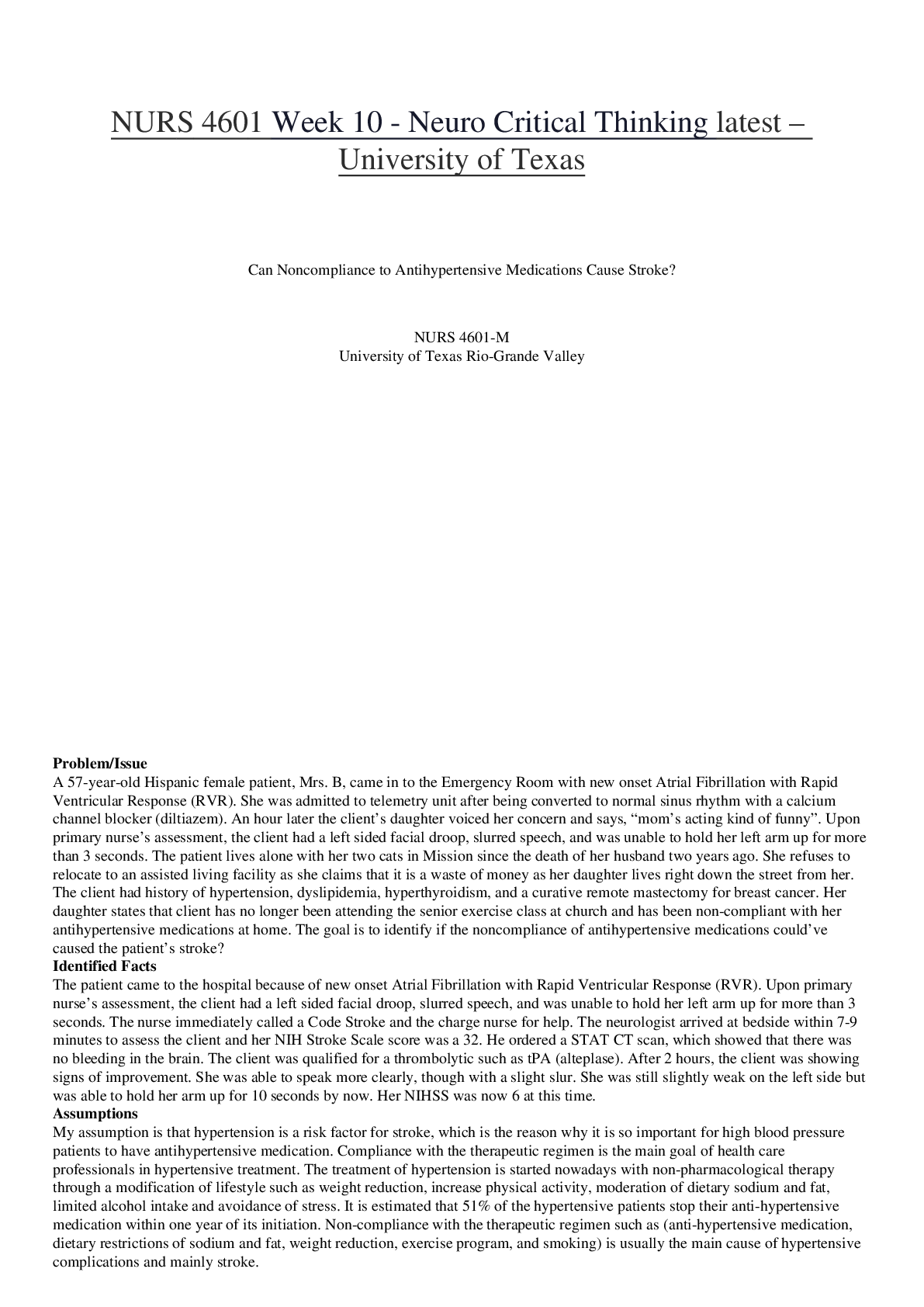
Reviews( 0 )
Document information
Connected school, study & course
About the document
Uploaded On
May 20, 2020
Number of pages
6
Written in
Additional information
This document has been written for:
Uploaded
May 20, 2020
Downloads
0
Views
47


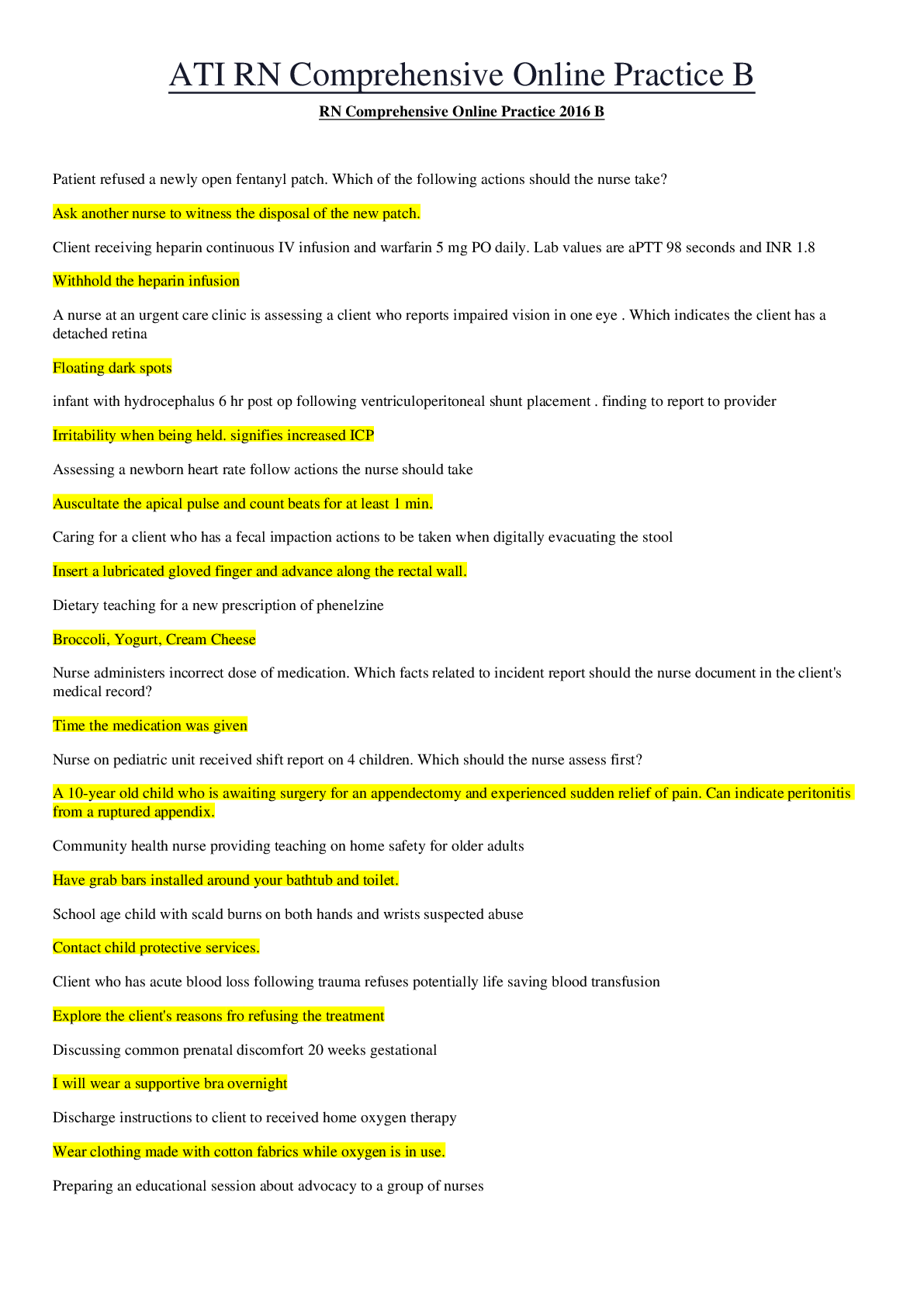
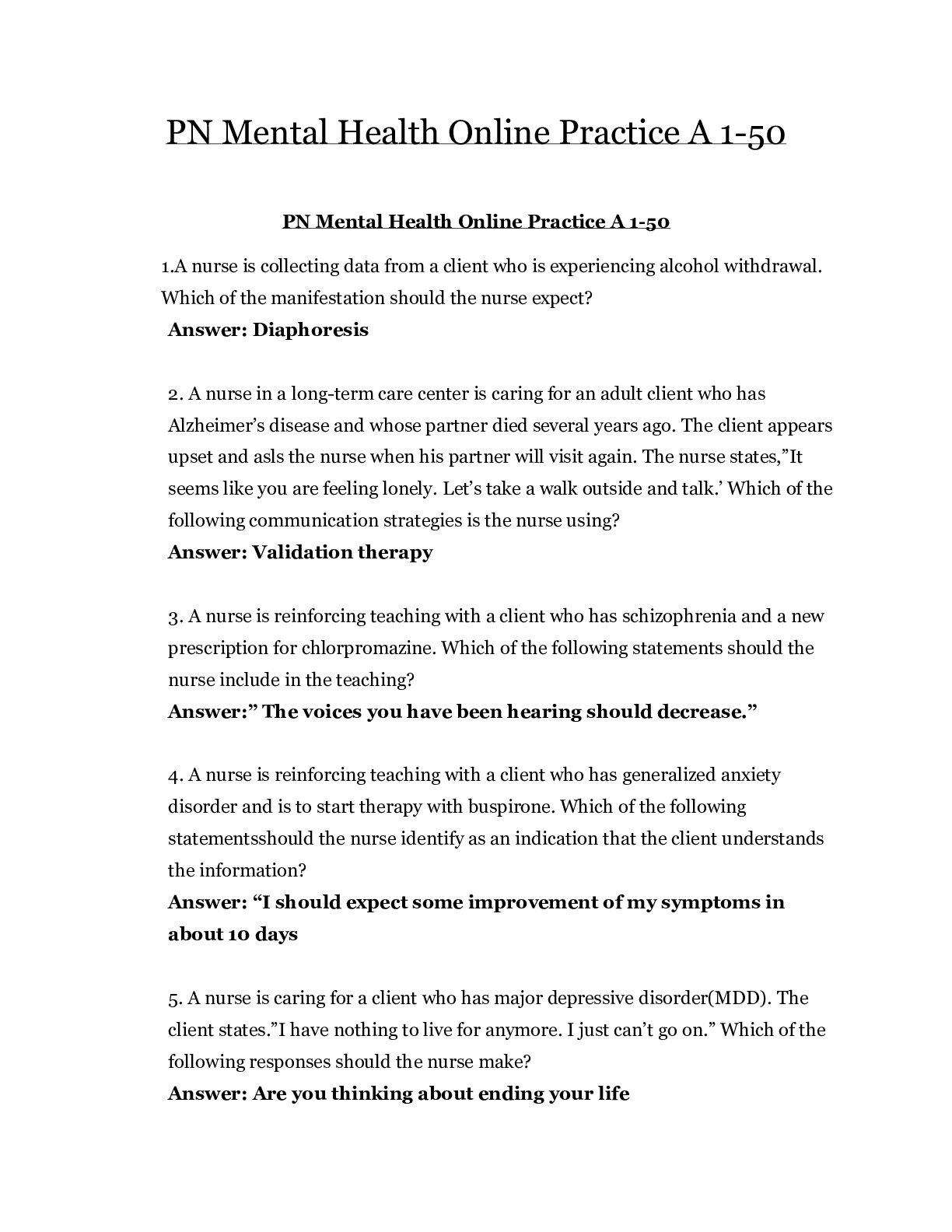
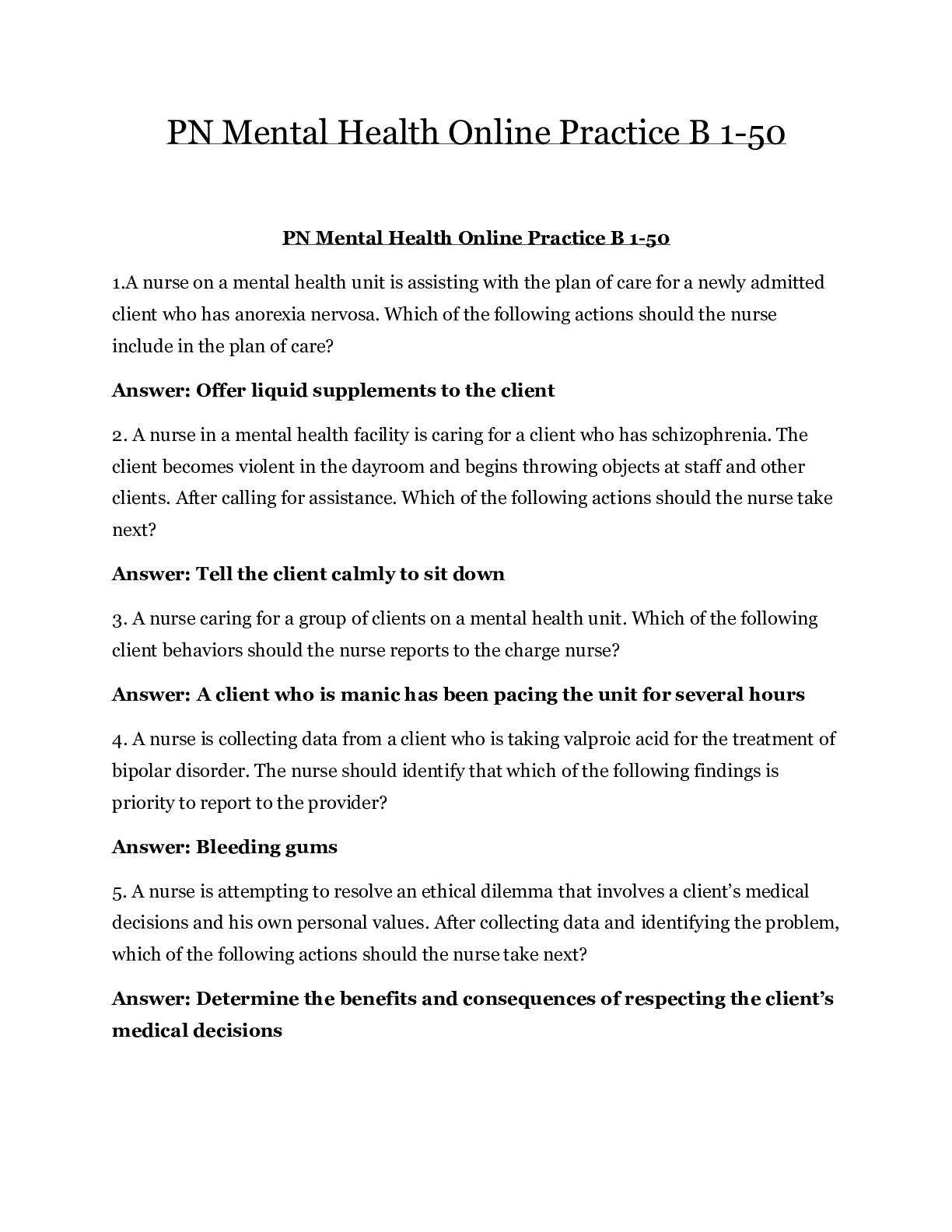
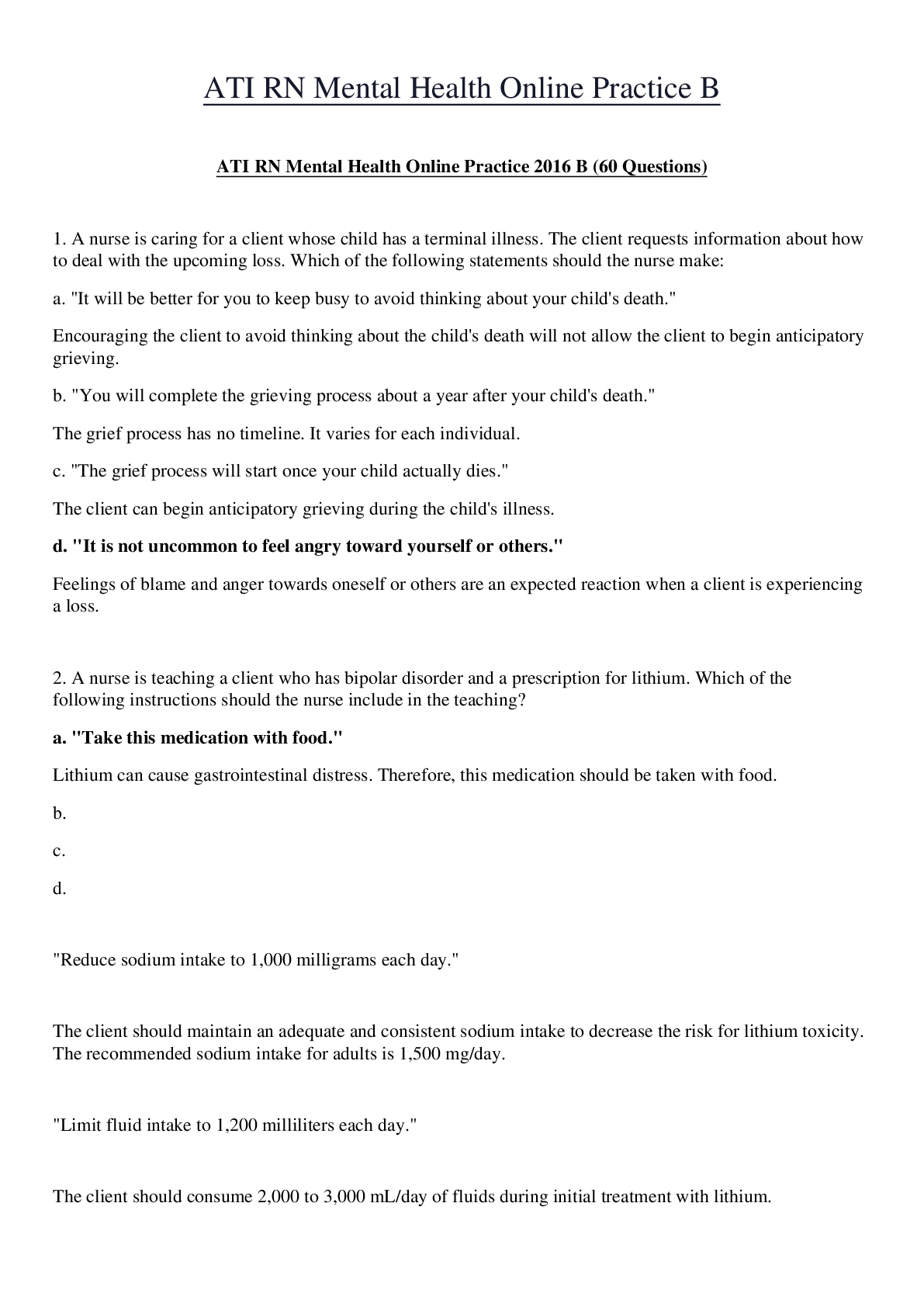


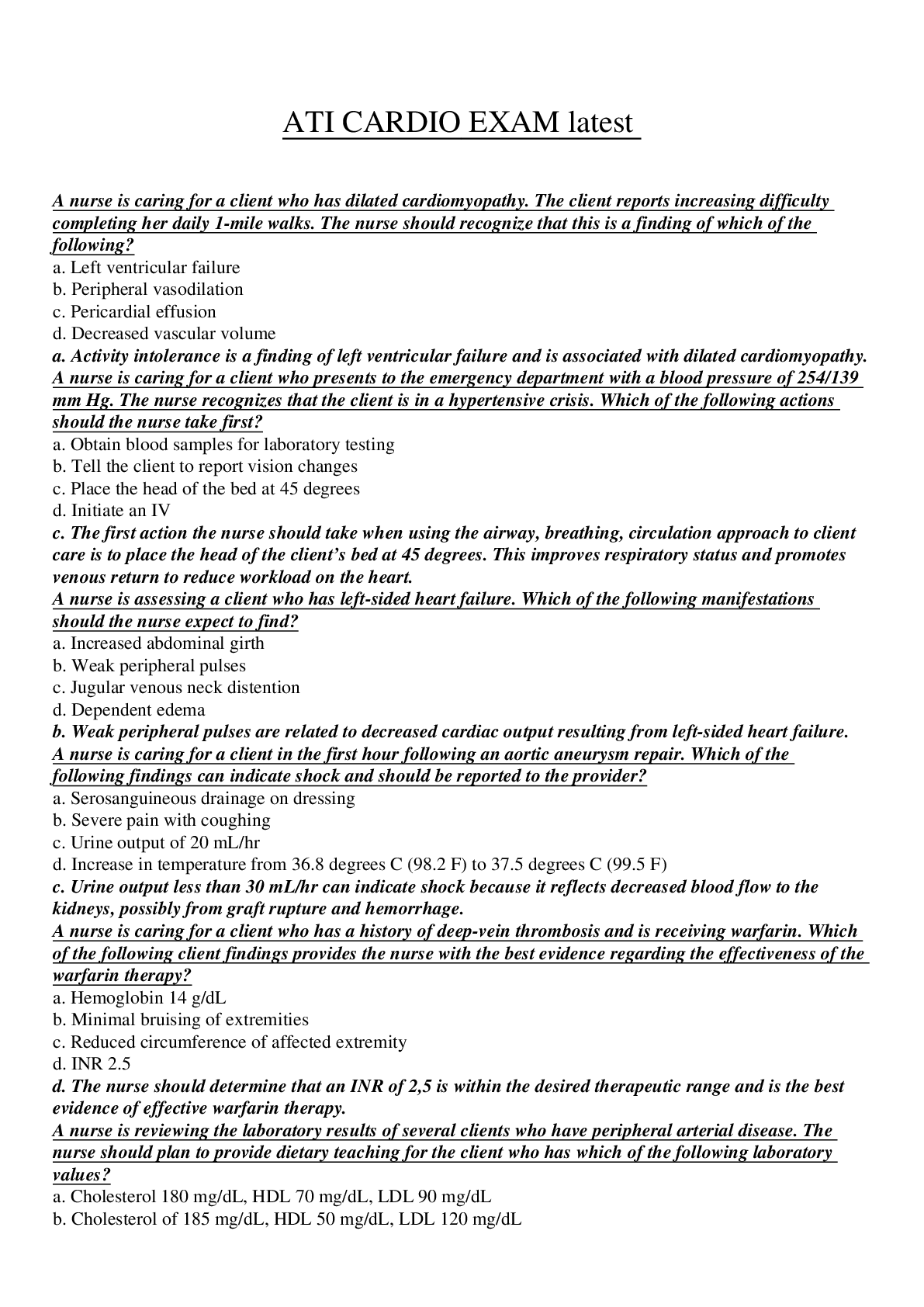
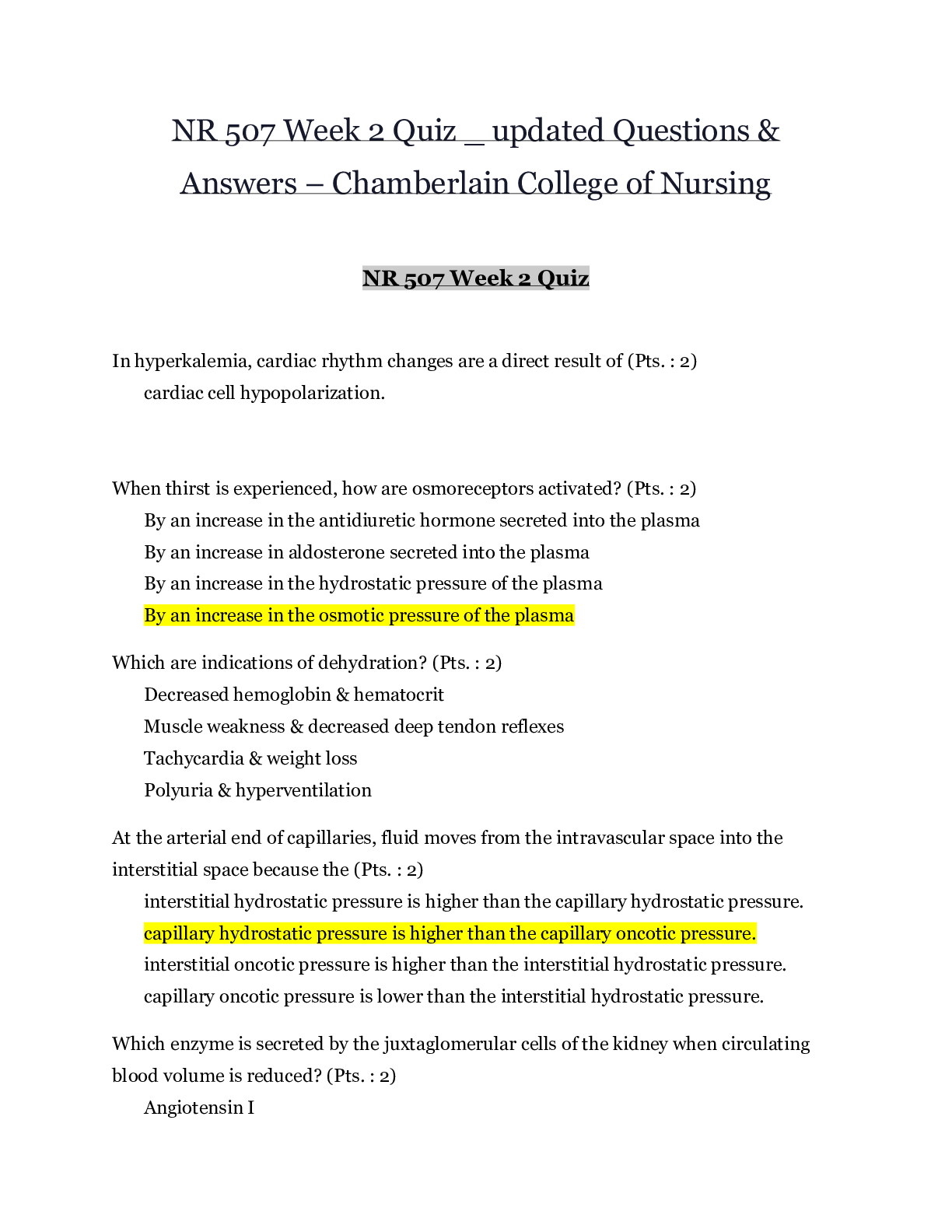
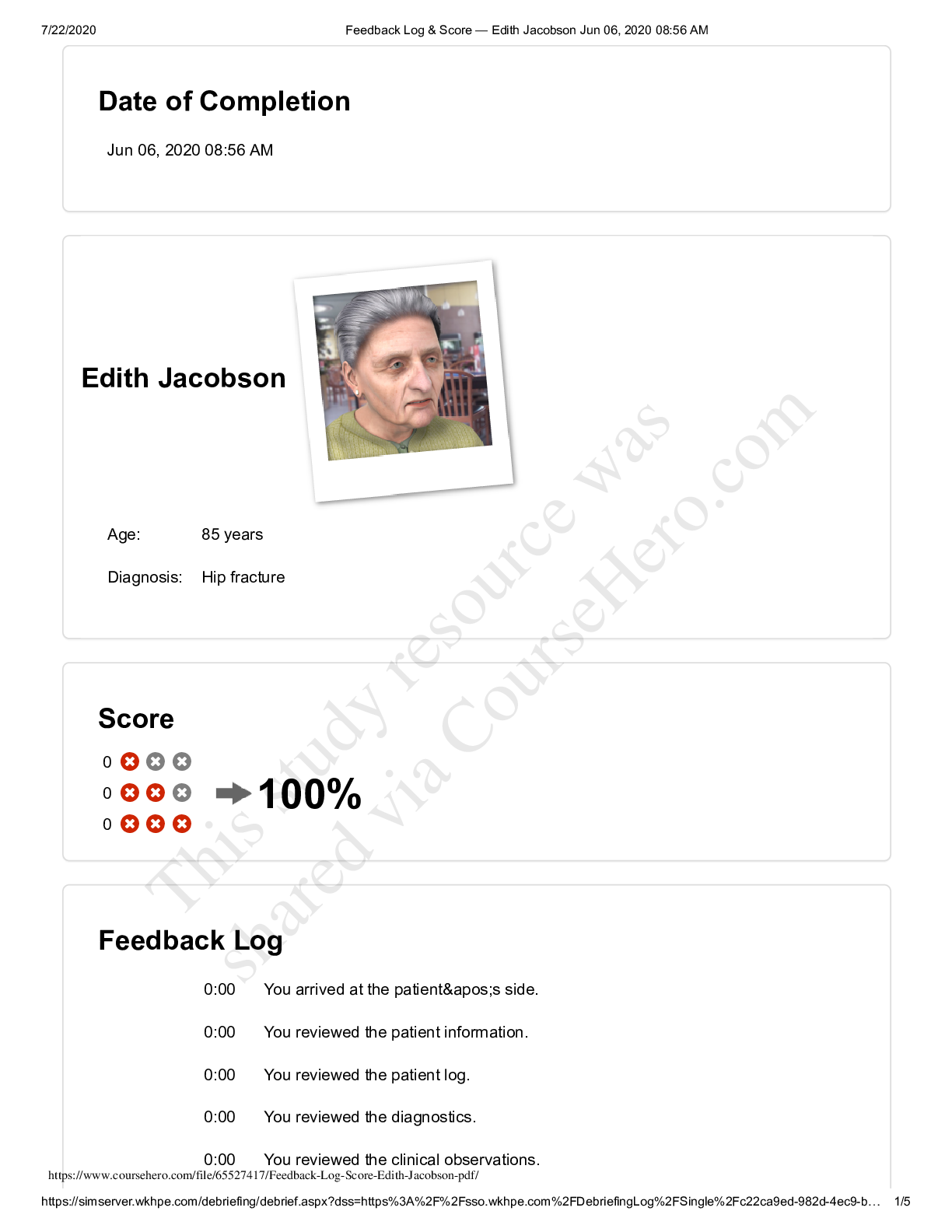
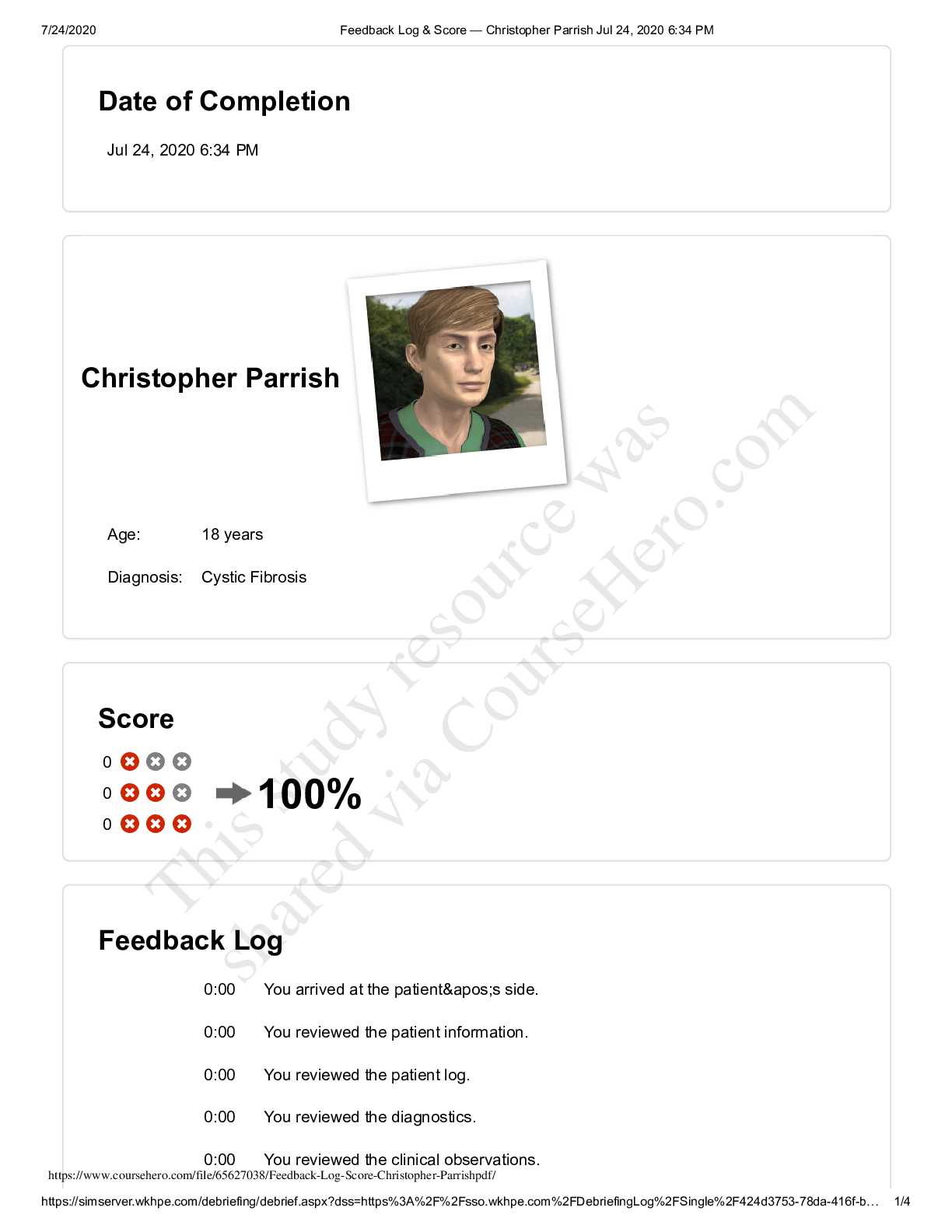
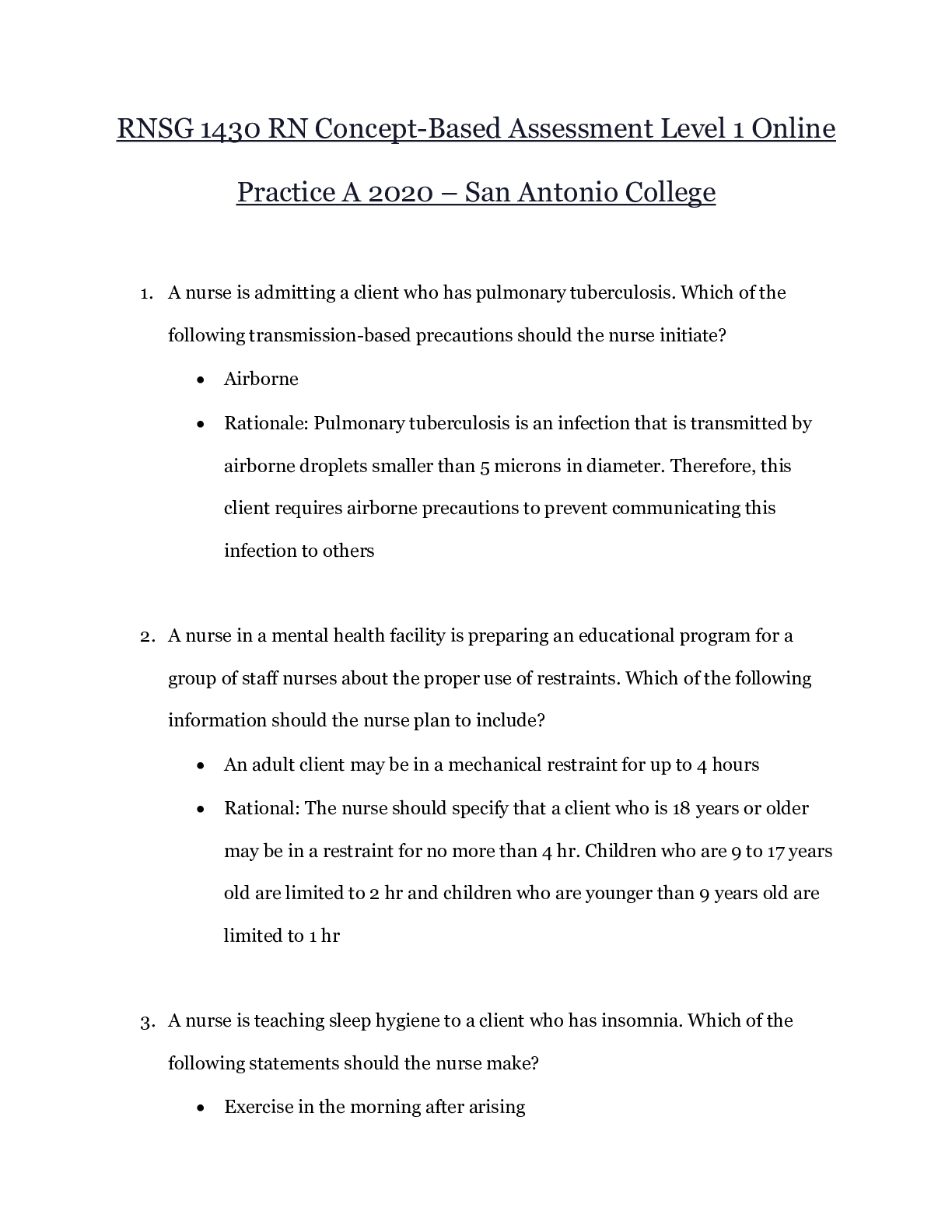


 – CHAMBERLAIN COLLEGE OF NURSING.png)
